True Crime in Old Stereographs
written for the stereosite by Martin Schub, USA
At a recent meeting of the VSC, someone asked if there are stereo views of true crime. I’m not a big true crime fan or a stereo scholar, but this seemed like a fun pandemic online research project. What is meant by true crime? It’s a nonfiction genre having to do with actual crimes, usually murder. It’s popular now, but it was popular in the 19th century too‒just think of the penny press and the National Police Gazette. As the joke says, “Crime may not pay, but it sells!”. I was curious to see if it made its way into stereo cards, too.
Almost all the material I found was for Americans. The images you’ll see come only from online sources, mostly the Library of Congress and the New York Public Library. I had never heard of any of these murderers, but amazingly, two of them have their own Wikipedia articles and I was easily able to find some material on the rest also. Conversely, I was unable to find material connected to some murderers who are still household names in the U.S., like Lizzie Borden or Alferd G. Packer.
In what follows, I’ve tried to provide a thumbnail sketch of each crime. Accounts from the time often vary, so I’ve tried to present a composite set of the facts which I think are the most likely.
Please note: Most of these stereos are G‑rated, but there are a few which may be disturbing to some people. Specifically, there are two hangings (both shown before the trapdoor opened) and one dead body. Also some of the descriptions of the crimes may be disturbing. These are images of murder and capital punishment, and they’re not pretty.
Assassinations
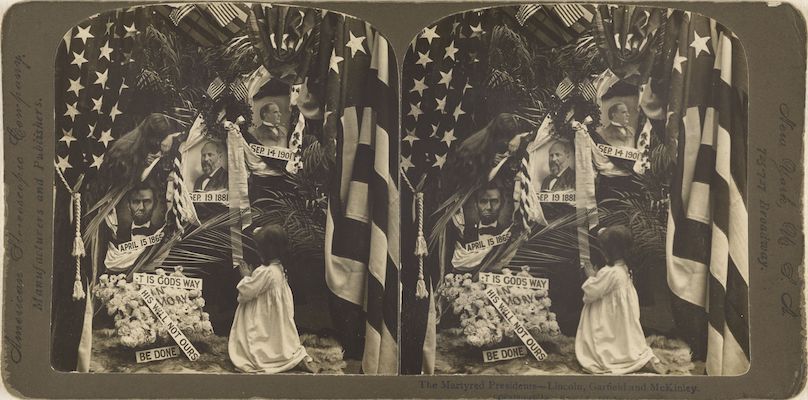
The first thing that comes to mind for true crime in stereo was Eadweard Muybridge, but more about him later. The second thing was the assassinations of three US presidents: Abraham Lincoln in 1865, James Garfield in 1881, and William McKinley in 1901. This stereo memorializes all 3, in true maudlin turn-of-the-century style, but with great stereoscopic depth!
Lincoln Assassination

This is the only stereo I could find of John Wilkes Booth, who shot Lincoln. It’s an accidental stereo, assembled by John J. Richter from two carte-de-visite images where Booth moved a little between exposures. As a result, the depth is a bit exaggerated.
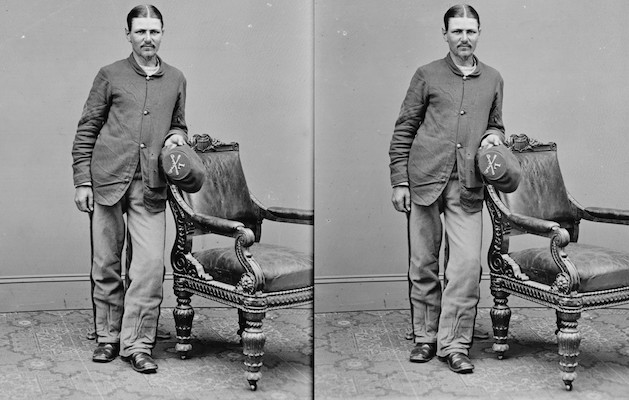
On April 26, 1865, Boston Corbett’s regiment had surrounded Booth and one of his accomplices in a tobacco shed in Virginia. They were under orders to take Booth alive, but somebody shot him anyway. There are doubts about whether it was Corbett, but he took the credit (or blame). He was to have been court-marshalled, but the Secretary of War intervened.
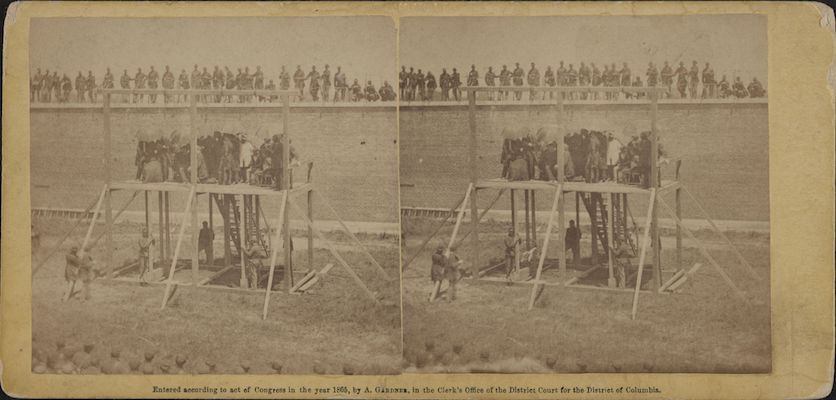
The assassination of Lincoln was part of a broader conspiracy. Booth isn’t in this photo, having already been killed. The hanged were: David Herold, who helped Booth escape, Lewis Powell, who tried to kill Secretary of War Seward, George Azterodt, who was supposed to kill Vice President Andrew Johnson but lost his nerve, and Mary Surratt, who owned the boarding house where the conspirators met, and who was the first woman to be executed by the U.S. government.
Garfield Assassination
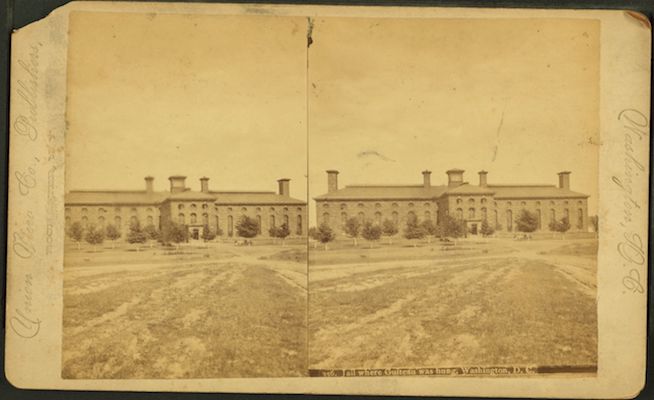
This is the old DC jail where Charles Guiteau, who shot President James Garfield, was held and eventually hanged. While he was held here, two attempts were made to shoot Guiteau, including one by one of his guards. People took up a collection for the guard‒that’s how popular Guiteau was.
It took Garfield almost 3 months to die after being shot, so in court Guiteau claimed, “The doctors killed Garfield ‒ I just shot him!”. He’s usually described as a “disappointed office seeker”, but I don’t think that fully captures his weirdness. He literally danced to the gallows, and then recited a poem he had written, titled, I am going to the Lordy. Both he and Booth are characters in the musical Assassins by Stephen Sondheim and John Weidman, parts of which are available on YouTube.
Plain Old Murders
Gaius Jenkins, Lawrence, Kansas Territory, 1858

There was a plenty of shooting in Kansas Territory in 1858 (the photo was taken some years later), over whether the state-to-be would have legal slavery. In this case, though, both men were Free Staters. What they couldn’t agree on was the ownership of a certain piece of land in Lawrence, including the well you see here (the wellhouse is at the far left).
On June 3, 1858, Gaius Jenkins, carrying a revolver, came to get water from the well which both he and Jim Lane claimed. Lane met him with a shotgun. A man with Jenkins shot Lane in the leg, and Lane shot and killed Jenkins. Lane was acquitted at trial and went on to become one of the two first U.S. Senators from Kansas, and overlapping his Senate service, a Union Civil War general, trading atrocities with the Confederates on the Kanas/Missouri border. In 1866 he became depressed and committed suicide.
Thomas Brown and Wife, Hampton Falls, New Hampshire, 1868
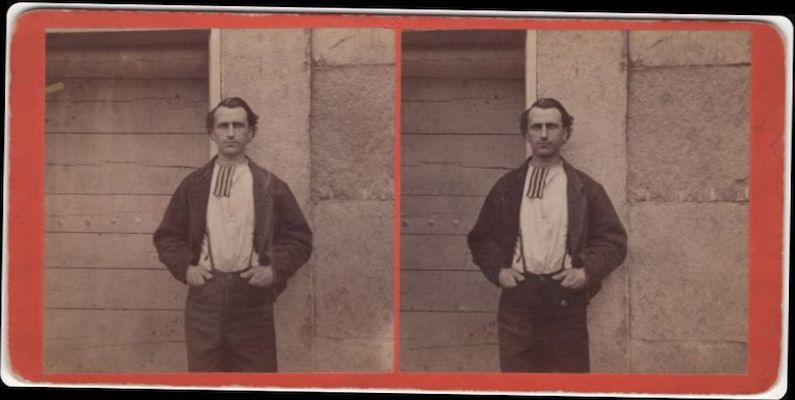
Josiah L. Pike murdered Thomas Brown and his wife, a couple in their 70’s, at Hampton Falls, New Hampshire, on May 8, 1868, with an axe. He stole $500 and an overcoat. He doesn’t look at all sorry in this photo. I haven’t found Mrs. Brown’s name mentioned anywhere, so far. A local church group seems to have been determined to save Pike’s soul by showering him with love, and they held his hand, brought him flowers, and had a choir sing to him. Mark Twain, disgusted by this, wrote a short but very snarky essay called Lionizing Murderers.
Jonathan Lunger and Marie Lunger, Ulysses, New York, 1870
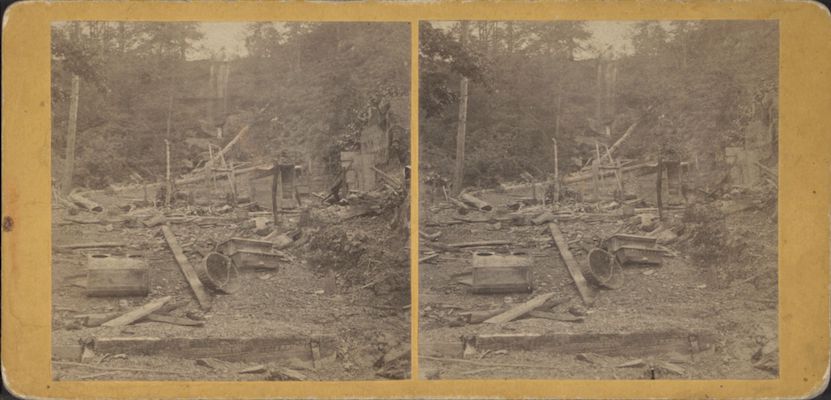
You are looking at the remains of a cabin near Ulysses, New York, which was burned to the ground on March 20, 1870. Two bodies, almost completely reduced to ashes, were found inside.
Jonathan Lunger and his daughter had been awakened by a sharp noise. Lunger found his arm covered in his wife Marie’s blood, and standing over her, holding an axe, was Mike Ferguson, a man who hung around near his cabin and whom he sometimes hired. After a short conversation, Ferguson stove in Lunger’s skull with the axe. Ferguson took Lunger’s watch and rifle and their little money and burned the cabin to the ground. He forced 14-year-old Anna to come with him.
Ferguson was caught and Anna was freed and testified at the trial. Ferguson was hanged at Ithaca in 1871. His motive for the crime was never clear.
Georgiana Lovering, Northwood, New Hampshire, 1872
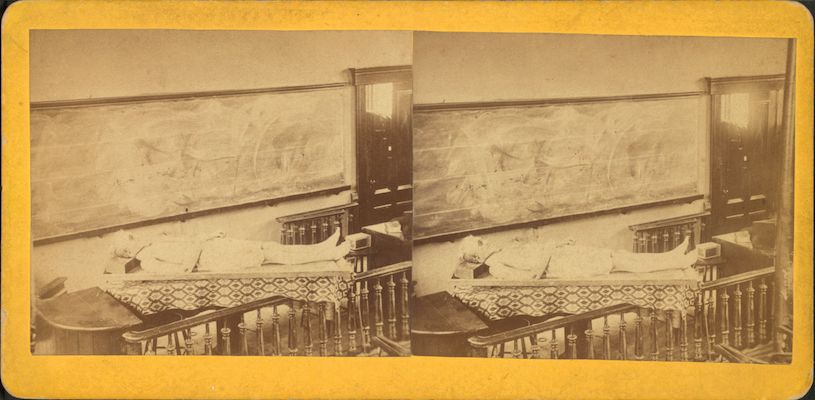
Franklin B. Evans had set some snares for the birds in the woods outside Northwood, New Hampshire. On September 25 of 1872, he asked his 14-year-old niece, Georgiana Lovering, to check his snares, claiming that he had to work. He hid, then followed her into the forest, then raped her, strangled her, and extensively mutilated her body with a knife.
Evans came up with a couple of stories about a mysterious stranger who had run off with the girl, but Sheriff Henry Drew spent a day with Evans driving from town to town to check the story as it changed. Finally, after they had returned to the sheriff’s house, Sheriff Drew locked eyes with Evans and asked him if Georgie were alive or dead. After some seconds, Evans broke and admitted that she was dead. At midnight, he led the sheriff through a swamp to the body. On viewing the body, the sheriff demanded to know where certain body parts had gone to, and Evans led him to a spot where he had buried them under a rock.
Before his execution on February 18, 1874, Evans confessed to another murder and mutilation of a child which he had committed in 1850. He was suspected of committing several others, but denied his guilt in those. He requested that his body be sold to the Dartmouth College medical school for dissection, with the money to go to his son. And that is where we see him here.
Karen and Anethe Christensen, Smuttynose Island, Maine, 1873
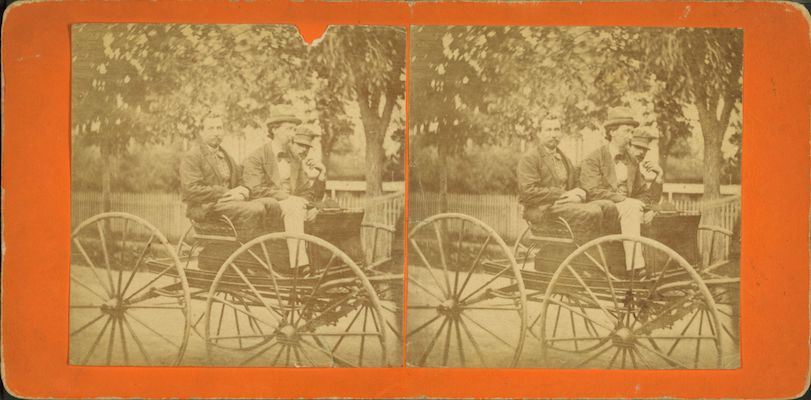
Louis H. F. Wagner is the fellow on the left. The position of his hands suggests that he’s trying to hide shackles. Unfortunately, this “stereo” view is really two copies of the same photo, so it has no depth.
On March 5, 1873, Norwegian immigrants Maren Hontvet and her sister Karen and sister-in-law Anethe Christensen were asleep in a house on Smuttynose Island, one of the Isles of Shoals off the coasts of New Hampshire and Maine. Wagner had found out that Maren’s husband John was staying on the mainland that night, and he thought that John had saved up $600 for a new fishing boat. He also knew the house well, having lived there at one time. Breaking into the house, he blundered into Karen, who was sleeping in the kitchen. He beat her with a chair, but Maren managed to drag her into a bedroom and shut the door. Maren screamed to Anethe, in the next room, to run, and Anethe left by her window, but Wagner grabbed an axe and followed, and cut her down. When he came back into the house, Maren tried to get Karen to flee with her, but the badly-beaten Karen didn’t have the strength. Maren went out the window and ran, hearing Karen’s last cries behind her. Wagner searched the house and found $16, then made himself a meal, before rowing back to the mainland.
Wagner escaped from prison but was caught 3 days after in New Hampshire. He was hanged at Thomaston, Maine in 1875, more than 2 years after the crime. The murders were the subject of A Memorable Murder, which appears in many true-crime anthologies. The recent novel and movie, The Weight of Water also involve these murders.
Thomas and Simeon Sturtevant, Halifax, Massachusetts, 1874
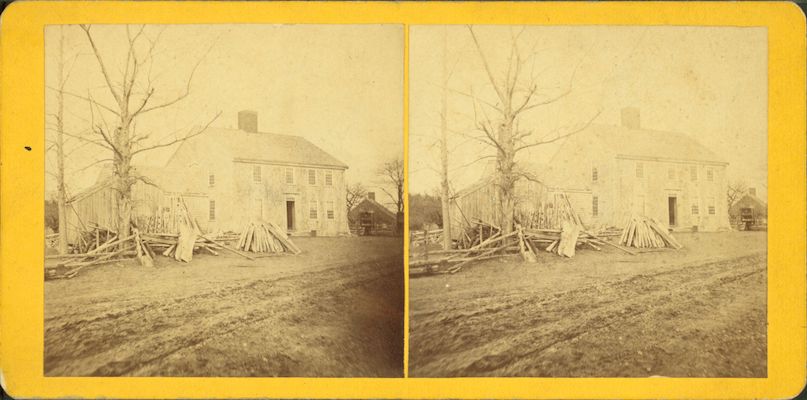
William Sturtevant was in debt and thought his grand-uncles had money. On February 15, 1874, he grabbed a long wooden stake and headed to this, their house. Grand-Uncle Thomas was on his way to the barn to feed his cows when William bludgeoned him. He then went into the house and bludgeoned his bedridden Great Uncle Simeon. He rifled the house for money, and on his way out the door he killed the housekeeper, Mary Buckley.
The interest in his execution was so great that tickets had to be issued. Interestingly, Historic New England says that the photographer worked for the county. It would be interesting to know the county asked for stereo photos, or whether he took them to sell for his own business.
Russell and John Allison, Putnam County, Tennessee, 1875
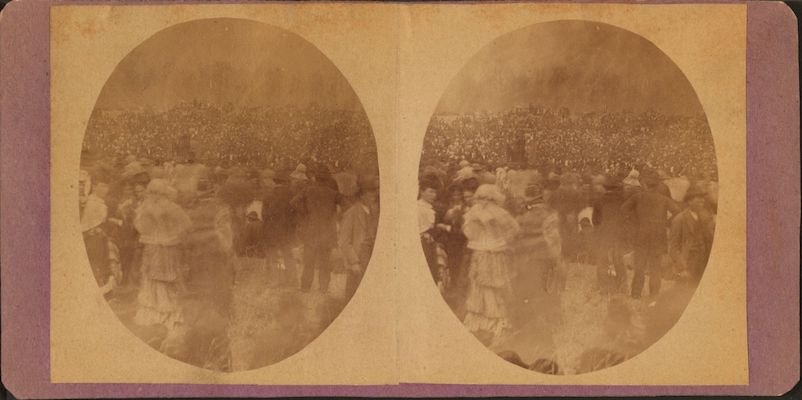
Joseph and George Brassel were brothers who murdered Russell Allison in Putnam County, Tennessee, on November 29, 1875, in the course of an attempted robbery. When a posse came to arrest them, they killed John Allison in the fight. He was Russell Allison’s brother. While in jail, they tried to poison their guards with arsenic which had been smuggled in to them. Then they broke their shackle chains by twisting them back and forth for many hours. Later they tried crawling out under the floorboards, but there wasn’t enough space. Near the end, they converted to the Methodist church. They dictated an account of their lives, which they thought they could sell. It included a list of their other crimes, some quite vicious.
At their hanging, they were allowed to speak to the crowd, and warned them of the evils of alcohol. A long ballad was written about their crimes and execution.
Afterward
I know there are more true crime stereos out there, based on listings in library and historical-society catalogs. As far as I can tell, though, they don’t form a particularly common stereo genre.
For more stereo true crime, see Richard C. Ryder’s article Murder, Madness, Muybridge, and Gull in Stereo World; those issues are available online (Part 1, Part 2). Eadweard Muybridge was not only a proto-cinema pioneer, but also a great stereographer, and a murderer. Philip Glass wrote an opera about him, called The Photographer. Ryder also proposes a possible connection to Jack the Ripper.
Martin Schub (Minneapolis, Minnesota, USA)
I’m a retired electrical engineer and one-time physicist, I’ve been taking stereo photos since the late 1980’s and I’m a member of the Minnesota Stereo Photography Club. I used a Stereo Realist for many years, followed by a homemade finger-sync digital rig, followed by a homemade StereoData Maker rig, and now I use a Fuji W1. I love stereo in all its forms. The feeling of looking through a window into another time and/or place never gets old.

